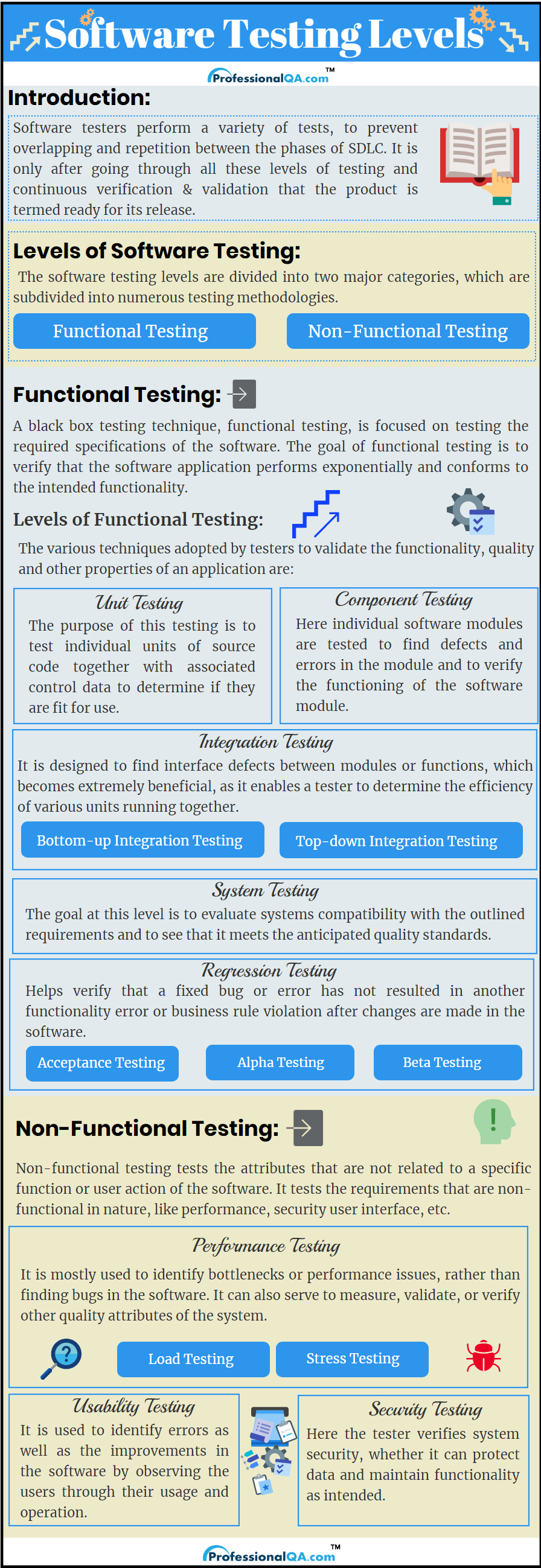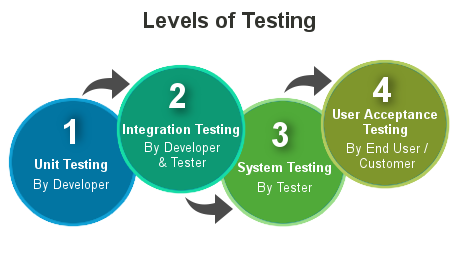

In Software development, testers and developers combine their expert knowledge and efforts to create an application or product that can be easily implemented and updated. Before the release, these products go through various testing processes, which guarantees that the application is working in an intended manner and is providing expected results. Moreover, the team of testers uses various levels of testing to identify missing areas and to prevent overlapping and repetition between the software development life cycle phases.
It is only after going through all these stages and continuous checking and rechecking, that the product is released for the use of the client or the end user. Therefore, to get a better understanding of various software testing levels, here is a detailed analysis of each level of software testing.
In order to develop products of superior quality and functionality, testers and developers all over the world use unique and different levels of software testing. These levels of testing include several testing methodologies that are used while conducting software testing to gain intended results and to fulfil the demands of the stakeholders. Each of these different testing levels has a particular purpose that provides extra value to the software development life cycle. The software testing levels are divided into two major categories, which further consist of numerous testing methodologies within them. These two categories of software testing are:
Lets go through these categories of software testing.

Functional testing is a type of black box testing technique, which focuses on the specifications of the software that are required to be tested. The goal of functional testing is to verify that the software application performs exponentially and conforms to the intended functionality.
During this form of testing, the tester checks the core application functions, text input, menu functions and installation, the setup on localized machines, among other things. Moreover, functional testing is conducted on a complete, integrated system to evaluate the system's compliance with its specified requirements.
To ensure effective testing practise and high quality of the product, the team of testers follow some important steps while performing software testing. The steps that are involved while testing the functionality of software are:
To check the functionality of software application, several techniques of functional testing are used by testers and developers during the process of software development. These, though vary in their specifications, aim at testing all the elements of a software as per their specifications and provide expected outputs.
Testers and developers use their expert knowledge to test and develop the software and make it error free before its release. The various techniques adopted by testers to validate the functionality, quality and other properties of an application are:

The first level of functional testing, Unit Testing, is the most micro-level of testing performed on software. The purpose of this testing is to test individual units of source code together with associated control data to determine if they are fit for use. Unit testing is performed by the team of developers before the setup is handed over to the testing team to formally execute the test cases. It helps developers verify internal design and logic of the written code. One of the biggest benefits of this testing is that it can be implemented every time a piece of code is modified, allowing issues to be resolved as quickly as possible.
Also known as a module and program testing,component testing is the phase in which individual software modules are tested to find defects and errors in the module and to verify the functioning of the software module. Component testing can be performed in isolation from the rest of the system, depending on the development life cycle model chosen for that particular application.
Integration Testing provides the opportunity to combine all the units within a program and test them as a group. This testing level is designed to find interface defects between modules or functions, which becomes extremely beneficial as it enables a tester to determine the efficiency of various units running together. Integration testing is further divided in two ways:
Begins with unit testing, followed by tests of progressively higher level combinations of units called modules or builds.
Tests the higher level modules progressively first and then focus on the lower level modules.
This is the first level of functional testing where the application is tested as a whole. The goal at this level is to evaluate systems compatibility with the outlined requirements and to see that it meets the anticipated quality standards. Performed by a knowledgeable and specialized testing team, system testing plays an essential role in the software development life cycle.
Performed whenever a change is made in a software application, regression testing helps in verifying that a fixed bug or error has not resulted in another functionality error or business rule violation. It makes sure that no new bugs or defects are uncovered due to minor or major modifications in the application. Other features of regression testing are:
The most important type of testing, Acceptance testing or User Acceptance Testing, is conducted by the Quality Assurance Team to check whether the application meets the intended specifications and satisfies clients requirements. Acceptance testing allows the tester to check for any undetected bugs, which can crash the system in the future. Once acceptance testing is accomplished successfully the application becomes suitable for release.
Alpha testing is carried out to ensure that the product is of good quality and also to prepare the system for Beta testing. Here, testers look into the quality as well as the engineering aspect of the developed application. Alpha testing is performed towards the end of the software development cycle, where the system is tested as a whole. Furthermore, this test is stimulated by a potential user or an independent test team at the developer’s site.
Field testing or Beta testing is executed once the Alpha testing is successfully performed. In beta testing, the test is carried out in a “real world” scenario, wherein the application is tested by people/users who will actually use the product. As beta testing is implemented before the release of the product, it is also known as pre-release testing. Other important features of beta testing are:
In non-functional testing, the attributes that may not be related to a specific function or user action of the software are tested. Non-functional testing involves testing of software from the requirements which are non-functional in nature but important, such as performance, security user interface and more. Some of the significant non-functional testing techniques are:
This is one of the most important and mandatory non-functional testing technique, which is generally executed to determine how a system or sub-system performs in terms of responsiveness and stability under a particular work load. Performance testing is mostly used to identify bottlenecks or performance issues rather than finding bugs in the software. Moreover, it can also serve to measure, validate or verify other quality attributes of the system, such as scalability, reliability, and resource usage. Performance testing can either be qualitative or quantitative, and can be divided into two categories:
Here the behaviour of the system is tested by applying maximum load in terms of software accessing and manipulating large input data. Load testing can be done at both normal and peak load conditions. This type of testing identifies the maximum capacity of software and its behaviour at peak time.
Is the testing done beyond normal operational capacity, often to the breaking point, in order to observe the results. It is a form of software testing that is used to determine the stability of a given system.
Usability Testing is a black box testing technique, which is used to identify errors and defects as well as the improvements in the software by observing the users through their usage and operation. This type of testing assists the tester in finding any undetected defects before the release of an application.
Security Testing is an integral part of the software development process. Through this type of testing the tester verifies system security, whether it can protect data and maintain functionality as intended. The aim of security testing is to check for flaws and errors in the software as well as the system in which it will be implemented, from security and vulnerability point of view. Some of the most important concepts covered by Security testing are:
Software development Life Cycle is a time consuming process that involves various methodologies and techniques. Testers and developers use their experience and knowledge to create products that are of exceptional quality and are designed as per the requirement of the clients. However, the most integral part of the software development process is testing, which is executed in the software through several levels.
In these levels, the individual units are tested, integrated and checked for interfaces established between them. After this, the entire software is tested to ensure that the output produced is according to user requirements. It is only after successfully accomplishing these levels that a software application is termed suitable for release.
Advertisement: